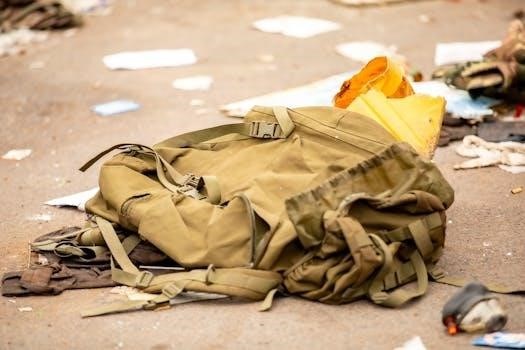Army Ground Guide Visual Signals are essential for clear communication on the battlefield. They provide a standardized method for directing vehicle movement and ensuring the safety of personnel. Efficient combat operations depend on these visual cues.
Importance of Visual Signals in Ground Operations
Visual signals are critical for maintaining effective communication when verbal communication is impossible. They ensure quick, accurate messaging, especially in noisy or dangerous environments. These signals enhance coordination between ground units and vehicles.
Ensuring Clear and Accurate Communication
In dynamic combat situations, clear and accurate communication is paramount. Visual signals provide a standardized method to convey critical information quickly and effectively, especially when verbal communication is compromised by noise or distance. These signals minimize misunderstandings between ground guides, vehicle operators, and other soldiers. Standardized hand signals, flag signals, and other visual cues facilitate seamless coordination during patrol, convoy control, and other ground operations. They also reduce the risk of accidents and enhance overall mission effectiveness by ensuring everyone understands the intended message, regardless of language barriers or environmental challenges.
Maintaining Operational Security
Visual signals play a crucial role in maintaining operational security on the ground. Unlike radio communications, hand and arm signals, flag signals, and pyrotechnic signals offer a discreet way to communicate without the risk of interception by the enemy. This is especially important in sensitive operations where secrecy is paramount. By utilizing pre-arranged visual cues, ground units can coordinate movements, issue warnings, and adjust tactics without revealing their intentions to potential adversaries. Using visual signals reduces reliance on electronic devices, ensuring a lower electronic signature and enhancing overall operational security in the field.

Types of Visual Signals Used
The Army employs various visual signals for communication. These include hand and arm signals, flag signals, pyrotechnic signals, and ground-to-air signals. Each type serves a specific purpose in different operational scenarios.
Hand and Arm Signals
Hand and arm signals are a fundamental method of visual communication within the Army; These signals are used in various scenarios, including directing vehicle movement, controlling combat formations, and during battle drills. Ground guides utilize specific hand and arm signals to communicate with vehicle operators, ensuring safe and precise maneuvering. These signals are crucial when verbal communication is not feasible due to noise or operational security concerns. The standardization of these signals, as outlined in documents like TC 3-21.60, ensures that all personnel understand and can effectively use them, promoting clear and accurate communication on the ground.
Flag Signals
Flag signals serve as an alternative visual communication method, employed in situations where hand and arm signals might be insufficient or impractical. Similar to hand signals, flag signals utilize specific flag positions and movements to convey prearranged messages. These signals can be particularly useful over longer distances or in environments with visual obstructions. The updated US Army visual signals manual includes flag signals for various scenarios, such as warnings about hazards. While less commonly used than hand signals in ground guide operations, flag signals remain a valuable tool in the broader spectrum of Army visual communication techniques, providing versatility in conveying information.
Pyrotechnic Signals
Pyrotechnic signals involve the use of flares, smoke grenades, and other explosive devices to transmit pre-determined messages across greater distances or to larger units. Unlike hand or flag signals, pyrotechnics offer a more conspicuous form of communication, suitable for alerting entire units to specific events or conditions. These signals can indicate enemy positions, mark landing zones, or signal the need for immediate support. Pyrotechnic signals are less frequently used for direct ground guide activities. Rather, they often support broader tactical communications. Their use demands careful planning to prevent confusion and to ensure safety protocols are strictly observed.
Ground-to-Air Signals
Ground-to-air signals are crucial for coordinating with aircraft, particularly helicopters, in direct support roles. These visual signals are used by ground forces to guide helicopters to landing points, signal for emergency extraction, or communicate information about enemy positions. Standardized arm-and-hand signals, along with specialized devices, facilitate clear communication between ground personnel and aircrews. These signals are particularly important in dynamic combat situations where radio communication may be compromised or unavailable. Effective ground-to-air signaling requires thorough training and a clear understanding of established protocols to ensure the safe and efficient coordination of air support assets during operations.

Ground Guide Signals⁚ Specific Applications
Ground guide signals are vital for directing vehicle movement in diverse scenarios. They ensure safety in congested areas and facilitate combat formations. These signals are crucial during battle drills and operational maneuvers.
Vehicle Movement and Safety
Ground guides play a pivotal role in ensuring the safe and efficient movement of vehicles, especially in congested or confined areas. Utilizing standardized visual signals, ground guides direct operators, preventing accidents and minimizing risks to personnel. Clear communication between the guide and the operator is paramount for successful maneuvers. These signals encompass instructions for forward movement, reversing, turning, and stopping, all crucial for navigating complex environments. A 360-degree walk-around inspection and pre-coordinated signals further enhance safety during vehicle operations, reducing the potential for mishaps and ensuring everyone’s well-being.
Combat Formations and Battle Drills
Visual signals are instrumental in executing combat formations and battle drills effectively. Soldiers employ specific hand and arm signals to communicate tactical movements, such as forming a coil or herringbone formation. These signals facilitate rapid adjustments during contact drills, indicating directions like “contact left” or “contact right.” Standardized signals ensure all members understand commands, even in noisy battlefield conditions. The ability to quickly adapt formations and execute drills using visual cues enhances unit cohesion, reaction time, and overall combat effectiveness. Clear, concise visual communication is vital for successful mission accomplishment in dynamic combat scenarios.
Standardization and Training
Standardization ensures all soldiers understand visual signals. Training, guided by resources like TC 3-21.60, is crucial. This ensures consistent interpretation and application of signals, leading to safer and more effective operations on the ground.
TC 3-21.60⁚ Visual Signals as a Training Reference
TC 3-21.60 serves as a critical training reference for Army visual signals. This guide standardizes hand and arm signals, flag signals, and other visual communication methods. It ensures soldiers have a common understanding of signals used in various operational scenarios. The manual provides detailed illustrations and explanations, facilitating effective learning. Soldiers must familiarize themselves with TC 3-21.60 to maintain clear, accurate, and secure communication on the battlefield. Proficiency in these signals enhances combat effectiveness and minimizes the risk of miscommunication during critical operations. It supports efficient combat operations.
Coordination Between Ground Guides and Vehicle Operators
Effective coordination between ground guides and vehicle operators is paramount for safe vehicle movement. Before initiating any maneuver, the ground guide and operator must establish a clear understanding of the signals. Pre-movement briefings should cover the intended route, potential hazards, and specific signals to be used. The ground guide acts as the operator’s eyes and ears, providing critical information about the surrounding environment. Operators must respond promptly and accurately to the ground guide’s signals. This collaborative approach minimizes the risk of accidents and ensures smooth, efficient vehicle operations in complex environments. Consistent communication is key.

Safety Considerations for Ground Guides
Ground guides must prioritize safety. This includes conducting a 360-degree walk-around of the vehicle and pre-coordinating signals with the driver. Maintaining situational awareness and clear communication are crucial for preventing accidents.
360-Degree Walk-Around Inspection
Prior to guiding any vehicle, ground guides must perform a thorough 360-degree walk-around inspection. This critical step involves meticulously examining the vehicle for any potential hazards or obstructions that could compromise safety during movement. The inspection includes checking for personnel, equipment, or obstacles in the vehicle’s path. It also encompasses assessing the surrounding terrain for potential risks such as uneven surfaces, ditches, or low-hanging branches. This proactive measure ensures that the ground guide is fully aware of the environment and can effectively prevent accidents, thereby safeguarding both personnel and equipment during vehicle maneuvers in the field.
Pre-Movement Coordination of Signals
Before initiating any vehicle movement, ground guides and vehicle operators must establish clear and concise communication. This involves a detailed pre-movement briefing to ensure mutual understanding of all signals to be used. The briefing should cover the specific hand and arm signals for various maneuvers, such as forward movement, stopping, turning, and reversing. Any potential ambiguities or variations in signal interpretation must be addressed and clarified. This collaborative coordination minimizes the risk of miscommunication, thereby promoting safe and efficient vehicle operations. It is critical that both parties acknowledge and confirm their comprehension of the agreed-upon signals before proceeding with any movement.

Evolution and Adaptation of Visual Signals
Visual signals are continuously evolving to meet modern battlefield demands. Adapting to technological advancements and changing operational environments is crucial. Integration with newer communication methods ensures continued effectiveness and relevance in contemporary military operations.
Modernization of Visual Communication Techniques
The modernization of visual communication techniques in the Army involves integrating new technologies while maintaining the effectiveness of traditional methods. This includes utilizing computer animations for training on proper visual signals, ensuring soldiers understand nuances even with technological aids; Modernization also encompasses adapting signals for use with night vision devices and incorporating digital tools for signal dissemination and interpretation. Furthermore, continuous updates to training manuals, like TC 3-21.60, ensure soldiers are equipped with the most current and effective signaling techniques, fostering clear and secure communication on the modern battlefield. These adaptations aim to enhance both safety and operational efficiency.
Integration with Other Communication Methods
The integration of visual signals with other communication methods enhances operational effectiveness in the Army. Visual signals are often used in conjunction with radio communication, allowing for redundancy and clarity, especially in noisy or communication-denied environments. For instance, a ground guide might use hand signals to direct a vehicle while confirming instructions via radio. This integration also extends to digital communication platforms, where visual signals can be supplemented with real-time video feeds or annotated maps. Furthermore, visual signals serve as a crucial backup when electronic communication fails, ensuring that missions can proceed even under adverse conditions. This multi-faceted approach ensures clear, accurate, and secure communication.

